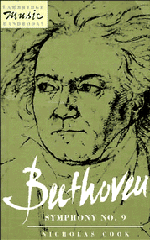Preface
Published online by Cambridge University Press: 08 January 2010
Summary
‘A fog of verbiage and criticism surrounds the Choral Symphony’, wrote Claude-Achille Debussy; ‘It is amazing that it has not been finally buried under the mass of prose which it has provoked.’ Disquieting words indeed for the author of a new handbook! But it is worth examining what Debussy is saying. He is approaching the Ninth Symphony rather as if it were an archaeological site; he implies that we need to dig away the debris of more recent times in order to uncover the work as Beethoven created it. Or we might liken the symphony to a painting, revealed in its original colours when the accretions and encrustations of later ages have been stripped off. In either case, the aim is to get back to the original. And this has been the guiding principle of most twentieth-century musicology; the performance practice movement is merely the most conspicuous example of such historical reconstruction, the aim of which is to reveal the music as its composer intended it. But, in the case of the Ninth Symphony, is erasing the accretions of history the most profitable way to approach the music? Is it even possible? ‘
This Symphony', wrote F. J. Crowest in 1899, ‘has that infinite sublimity and dramatic power, that sympathy with humanity which make it the most wonderful musical revelation that could be desired, or that is ever likely to be devised.’
- Type
- Chapter
- Information
- BeethovenSymphony No. 9, pp. vii - xPublisher: Cambridge University PressPrint publication year: 1993



